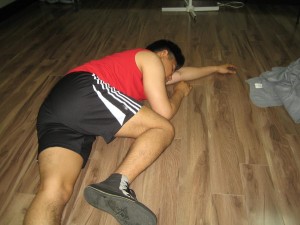The trauma triad of death is a group of interrelated symptoms which includes, hypothermia, coagulopathy and acidosis that if left untreated, may lead to death.
The trauma triad of death is a group of interrelated symptoms that if left untreated, may result to irreparable tissue damage and even death. These three conditions is a vicious cycle that begins with hypothermia that will eventually result to coagulopathy due to the temperature dependence of all clotting mechanisms. This will be followed by acidosis. The three conditions will compound one another in an intensifying chain of events. When an individual begins to show the trauma triad of death, it is considered a medical emergency.
Hypothermia is considered the entryway to the triad as clotting mechanisms are dependent on the temperature. When the body decreases in temperature, no clotting occurs, leading to coagulopathy. As a result, haemorrhage will cause a decline in blood pressure and amount of available oxygen, resulting to the cells transforming to anaerobic metabolism. Subsequently, the release of lactic acid will further inhibit clotting and cellular function. Consequently, there will be a reduced cardiac output causing even less oxygen to be available. The decreased myocardial performance will also lead to hypothermia.
Trauma Triad of Death: Hypothermia
Hypothermia is when the body temperature drops to below the temperature essential for normal metabolism and other body functions to occur. The following facts are known about hypothermia, the first step in the trauma triad of death:
- Occurs when body is below 35°C (95°F), versus normal body temperature which is approximately 37°C plus minus 0.5°C (98.6°F)
- Body is losing more heat than it is producing
- May affect thinking and lead to confusion
- Usually caused by spending too much time outside in an extremely cold weather
Trauma Triad of Death: Coagulopathy
Blood clotting is essential to stop bleeding. Normal blood clotting is temperature dependent, thus when the core temperature is too low, certain body functions cannot occur, which includes coagulopathy. Thus, bleeding may be difficult to control. The following facts are known about coagulopathy, the second step in the trauma triad of death:
- Also called bleeding problems, as there is impairment in body’s ability to clot
- Series of steps that involves 20 different plasma proteins (also called coagulation or blood clotting factors)
- May cause excessive bleeding
Trauma Triad of Death: Acidosis
Acidosis is a condition wherein there is too much acid in the body fluids. Acidosis is caused by too much carbon dioxide in the body or due to too much acid production. The following facts are known about acidosis, the third step in the trauma triad of death:
- Proper blood pH should be within the range 7.35 to 7.45
- Proper pH levels is maintained by the kidneys and lungs
- May lead to depression of the central nervous system
Causes of Trauma Triad of Death
The following are some examples of causes that may lead to the trauma triad of death:
- Car accidents
- Falling from great heights
- Severe bleeding or haemorrhage
- Shock
First Aid Management for Trauma Triad of Death
It is necessary to apply first aid in first signs of hypothermia or severe bleeding to prevent the onset of trauma triad of death. Because trauma leads to the triad of death, following steps are generally recommended:
- Call for emergency medical services.
- If protective gear is available, make use of them.
- If there is bleeding, it is necessary to control bleeding. Apply deep, direct pressure using an absorbent cloth or dressing. Keep the pressure in place and apply dressings over the old ones.
- Check for the victim’s circulation, airway, breathing, disability/ deformity and exposure.
- Check for the victim’s pulse by the groove on the neck. If no pulse is detected, initiate CPR. Give 30 chest compressions and 2 rescue breathings.
- If the victim is unconscious, ensure that there is no obstruction in the airway. Turn the victim’s head to the side.
- To check for breathing, position own cheek a few inches from the victim’s nose and mouth. Feel for air and watch for rise and fall of chest. Begin rescue breathing if necessary.
- Cover the victim with a blanket or coat to avoid heat loss.
It is necessary to be observant for symptoms of the trauma triad of death in cases of emergencies. Enrol in First Aid Training and CPR Courses to learn how to recognize symptoms, and effectively and properly perform CPR to victims. CPR is a lifesaving technique that can be useful in avoiding the onset of the trauma triad of death.
Sources:
Acidosis. (2011). National Institute of Health. Retrieved on October 15, 2013, from http://www.nlm.nih.gov/medlineplus/ency/article/001181.htm
Bleeding Disorders. (2011). National Institute of Health. Retrieved on October 15, 2013, from http://www.nlm.nih.gov/medlineplus/ency/article/001304.htm
Hypothermia. (2012). National Institute of Health. Retrieved on October 15, 2013, from http://www.nlm.nih.gov/medlineplus/hypothermia.html
Stopping the triad before it starts. (ND). Mayo Clinic. Retrieved on October 15, 2013, from http://www.mayoclinic.org/medicalprofs/trauma-triad-of-death-tue1012.html

